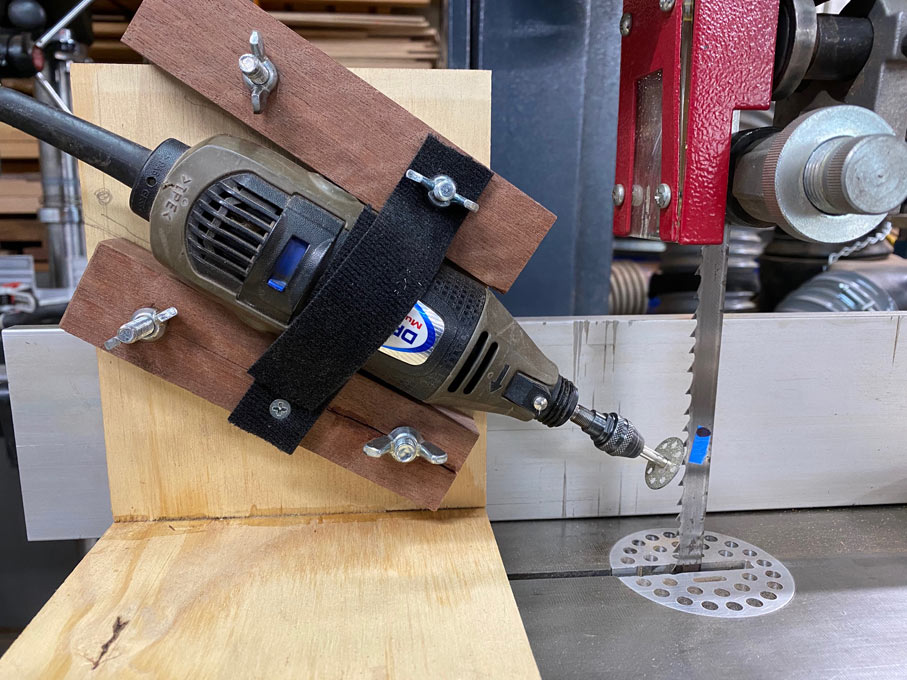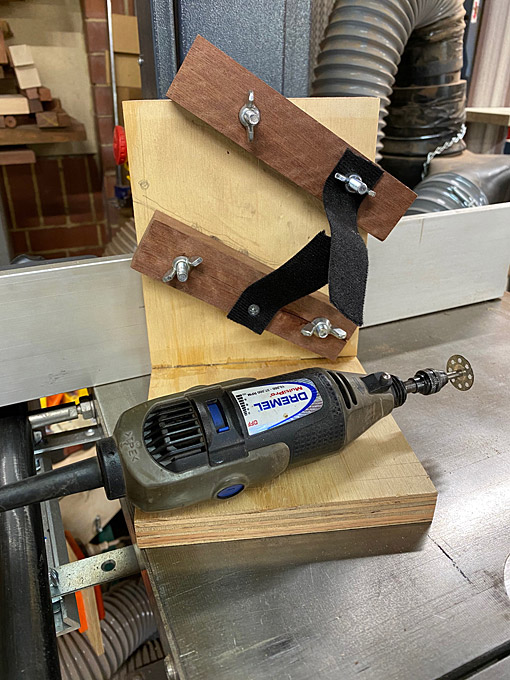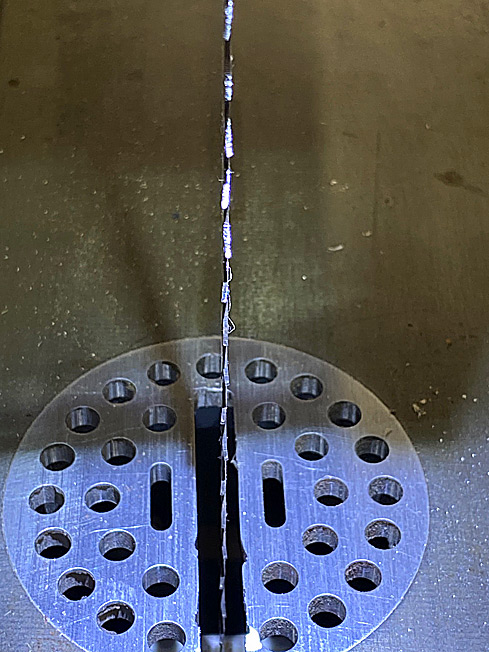Back
to Powered Tools and Machinery
Sharpening
Bandsaw Blades
I
was asked to explain how I go about sharpening my bandsaw blades, and
finally got around to putting together a couple of photos.
Let
me say first that I did not invent this method. It is widely used. I
learned it on YouTube, that font of all important wisdom 
The
fixture is new, and really thrown together in about 20 minutes.
Before this, for a number of years, I would simply freehand this
process. That worked well. Eventually .. recently .. I decided a
fixture would offer more reliable results and less hand fatigue.
Well, I think that this is so.
The main tool is a Dremel
with a small diamond disk (the disks are available for pennies on
eBay).
The blade here is bimetal 3 tpi 10mm wide. These
are easy to sharpen. I use these blades for most everything except
re-sawing wide boards.
I have also very successfully
sharpened a 1.3 tpi 1" Lenox Woodmaster CT, which is a carbide
tipped resaw blade.
The
set up ...

This
is made of two pieces of ply, at 90 degrees, the Dremel is wedged
between the brackets at the desired angle, and held on with velcro
straps ..

The
method ...
Simply
"touch" the back of the tooth and grind a teensy weensy
flat. Damn these technical terms - not too complex I hope? The angle
I choose is in line with the back, but it is not critical. What I
believe that the fixture does (better than freehanding) is keep the
height of the teeth the same. That ensures that all teeth are
cutting.
Step 1. Mark the start of the blade (blue
tape).
Step 2. Set the fixture against the bandsaw fence
to keep it tracking square.
Step 3. Gently touch the wheel
to the back of the tooth. Gently – enough to leave a silver
flat.
Below you can see (not too well, I'm afraid - the
shiny spot looks the length of the tooth, which it is not) a tiny
silver shine on the back of the teeth sharpened, and the absence of
this on those unsharpened ... a better picture would resemble the
sharpening of a backsaw ..

The
result ...
The
wood here is hard, dry Jarrah. The two sides are the result of
cutting with a freshly sharpened blade.

Additional
notes
Regarding
matters such as indexing and sharpening the face vs back ...
I
do not index - this method is as basic as it can be without doing it
freehand. It is better than freehand, as the angle is
consistent.
How
long can it be done? I have used the freehand method for several
years, and sharpened the 10mm bimetal blades about 5 times. Then I
toss them. I would say that I have had my monies worth. The cut can
get slightly smoother each time since there is fractionally less set
with each sharpening.
What
limits how long you can re-sharpen is, firstly, the size of the
gullet - too small and it cannot carry away sawdust, and then it
loads up and affects tracking. The second factor is the stiffness of
the blade. Carbide blades are stiffer as they are thicker. They
eventually fracture, and this is more common among bandsaws with
smaller wheels, such as 14” (more bending). My Hammer has a roughly
18” wheel, and my last 1” Lenox Woodmaster CT, a carbide re-saw
blade, disintegrated. It had been sharpened about 5 times.
Back
vs front? Not much difference - both leave the bevel edge sharp by
removing the wear bevel.
Here
is a method (by Terry Gordon, from HNT Gordon tools) for sharpening
the front. A guide is important as there is some risk that one may
alter the cutting angle by sharpening the front if you do this
freehand
...
https://m.youtube.com/watch?lc=z12rvxpzls35uty5n04cefehzquxtjnzdt00k&v=vKnlQ6ANNO0
The
number of teeth come into the equation. Too many and it will take
hours. The 10mm 3tpi bimetal blades take about 20-30 minutes. The 1.3
tpi 1” blades take about 10-15 minutes.
I
leave the blade on the bandsaw - some like to do this task freehand
on a bench grinder, and remove the blade to do so. Leaving the blade
on the bandsaw makes it easier to keep the angle consistent ... and
yet the bench grinder method still works well, which says that the
sharpening is quite accomodating to angles. I do release some of the
tension from the bandsaw, and work with the blade moving down. This
is less tiring.
Regards
from Perth
Derek
November
2020



